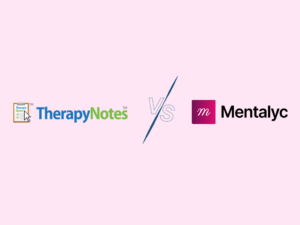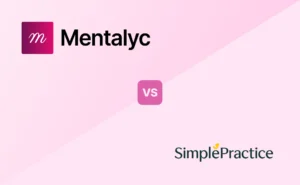Mental health documentation is an essential aspect of psychotherapy sessions. Documentation helps mental health professionals track progress from session to session, bill insurance, and helps justify why the client is there.
Many mental health clinicians like to follow a specified format for progress notes. Following a format helps ensure you’re meeting insurance requirements and enables you to demonstrate medical necessity, which most insurance companies require.
One potential format you can use for note writing is the PIE format. PIE notes are short and sweet and help you condense the essential information into three short sections. Due to their brief nature, you won’t have to spend loads of time on documentation, and you can get back to focusing on other priorities.
What is a PIE note?
A PIE note is a method of documentation used for health professionals that helps document a session or interaction. Mental health professionals may use the PIE note format for its ease and brevity. However, insurance companies don’t dictate that professionals follow a specific format.

New! Transfer your notes to EHR with a single click. No more copy-pasting.
Pie notes have three short sections and are problem-focused. PIE is an acronym for each included section.
P: The P in the PIE note stands for the problem. For mental health professionals, this section would include the presenting problem and focus on issues that bring the client to therapy. In addition, this section may consist of relevant mental health diagnoses.
I: The I in the PIE note stands for intervention. The clinician provides interventions to help the client alleviate the problems they came to therapy for. Interventions involve any action the mental health professional takes to help the client with their situation.
E: The E in the PIE note stands for evaluation. This section focuses on whether the client was responsive and open to the interventions of the clinician. This part of the PIE note may also include areas for further monitoring or may discuss the next steps of the clinician or client.
Benefits of PIE Notes
PIE notes are short and don’t take up much of your time. They are clear and concise about the client’s problem, what the mental health professional attempted to do in response to it, and how the intervention worked.
PIE notes are an easy-to-learn format. Despite their brevity, they’re still detailed enough to demonstrate the medical necessity and are a good choice for clinicians who want to get their notes done fast.
Examples of PIE Notes
PIE notes can look different depending on the client’s presenting problem. Here are three examples of PIE notes with varying client populations.
Example of a PIE note for a client with depression:
Problem: The client presents for therapy due to a loss of appetite, lack of motivation, and feelings of hopelessness. The client reports that these feelings have occurred for the past six months. They were urged to come to therapy by their partner, who is growing increasingly concerned about them. They report suicidal ideation at times but deny current thoughts, plans, and intent. The client wants to work on alleviating symptoms of depression and increasing motivation.
Intervention: The therapist gathered background information from the client regarding their depression symptoms. The therapist assisted the client with developing a safety plan. Their safety plan addressed warning signs that they need help, coping skills, a positive support system, and ways to make the environment safer. The therapist will continue to address symptoms of depression using a CBT approach and will meet with the client again in one week for a session.
Evaluation: The client was open and honest with the therapist during this session. The client was open to discussing suicidal thoughts they have had in the past and discussed the thoughts and feelings they’re having when they’re experiencing suicidal ideation. They identified coping skills and supportive individuals to include in their safety plan. They’re willing to work on their depression during treatment.
Example of a PIE note with a couple
Problem: The couple presents for therapy because they want to work on their relationship after an affair. After one partner was initially unfaithful and partner b discovered the infidelity, partner b also engaged in an extramarital affair. The couple reports that they want to work on communicating difficult emotions to each other without arguing. They want to remain in a monogamous marriage where they can repair and rebuild trust. Finally, they state that they want to learn practical conflict-resolution skills.
Intervention: The clinician worked to help the clients identify root factors that led to the affair and methods of communication. The couple was able to identify and process that communication had been challenging and ineffective before the affairs that they both had. The therapist educated the couple on practical communication skills and provided psychoeducation on rebuilding trust.
Evaluation: The couple states they are open to implementing new communication strategies at home and discussing difficult emotions. They openly discussed ways to learn to accept the previous affairs on both sides for what it is and discussed methods of moving forward rather than remaining stuck in the past. The therapist will continue to work with them on these goals and monitor the couple’s future progress.
Example of a PIE note for a child
Problem: The child presents for therapy at the request of the child’s mother. The client’s mother reports that the child is having difficulty expressing emotions, and this causes the child to have outbursts where the child hits objects in the home.
Intervention: The therapist used sand tray therapy techniques to allow the child to express emotions in a safe environment. The child was observed banging toys together, slamming the toy figurines into the sand, and burying the toys. The therapist discussed parallels between the child’s actions with the toy figurines and how that might relate to how she’s been feeling lately.
Evaluation: The child was hesitant to communicate verbally with the therapist, as she made it clear at the beginning of the session that she didn’t want to be in therapy, as evidenced by her screaming, “I want to go home!” Eventually, the child’s mother convinced the child to stay, and after about 10-15 minutes of the child sitting with the therapist, the child wanted to play with the sand tray. She was able how to talk about how she felt like the figurines that she was playing with. The therapist will continue modeling healthy emotional expression to the child in future sessions.
PIE Notes vs. Other note formats
PIE notes can be used for mental health documentation and other healthcare interactions, such as between patients and nurses. However, other formats for mental health documentation may be more popular or widely used than a PIE note.
Formats like SOAP, DAP, BIRP, PIRP, and GIRP notes may be more popular. They also have different sections in their structures. Many of these formats have a place to document subjective and objective information or state the client’s goals in a specified area. All other formats except for PIE notes also include a plan section outlining the next treatment steps.
Although there is no plan section in a PIE note, you can still outline the next steps for treatment in the evaluation section of a PIE note. Insurance companies don’t usually dictate what type of note format you use if you provide a rationale for the client’s treatment. As a result, PIE notes are a good option for some clinicians, and others may choose a more popular format. Writing PIE notes can be a breeze as they include small, easy-to-remember sections.
Tips for writing PIE notes
If you need strategies for writing PIE notes, ask yourself pertinent questions based on each section of the PIE note.
For example, in the problem section, you might ask yourself questions such as:
Why is my client here?
What problems or stressors is my client having?
How long has my client’s problem been occurring?
What do they want to achieve in therapy?
These questions may provide clarity and help you tailor what goes into the problem section.
In the intervention section, you may focus on questions such as these:
What did I do as the mental health clinician to help the client reach their goals?
How did I assist the client with their problem?
In the evaluation section of a PIE note, you might ask yourself questions such as these:
How did my client respond to my interventions?
What is their diagnosis, and how does that impact the client’s response to my interventions?
Did the client appear open to new interventions or closed off to new ones?
The Bottom Line
PIE notes are a type of format used for health professionals. Mental health professionals may use PIE notes to help document psychotherapy notes, which must be kept. PIE notes make documentation short and sweet and help the clinician quickly record psychotherapy sessions and show compliance with medical necessity needed for insurance companies.
Finding a guide for each of the three sections in a PIE note may be helpful to speed up the documentation process. The more you practice this documentation, the easier it gets to record. PIE notes may not be for everyone, but they are easy to learn if they work for you.
Disclaimer
All examples of mental health documentation are fictional and for informational purposes only.
Why other mental health professionals love Mentalyc

“A lot of my clients love the functionality where I can send them a summary of what we addressed during the session, and they find it very helpful and enlightening.”
Therapist

“Having Mentalyc take away some of the work from me has allowed me to be more present when I’m in session with clients … it took a lot of pressure off.”
LPC

“It takes me less than 5 minutes to complete notes … it’s a huge time saver, a huge stress reliever.”
Licensed Marriage and Family Therapist

“It’s so quick and easy to do notes now … I used to stay late two hours to finish my notes. Now it’s a breeze.”
Licensed Professional Counselor






